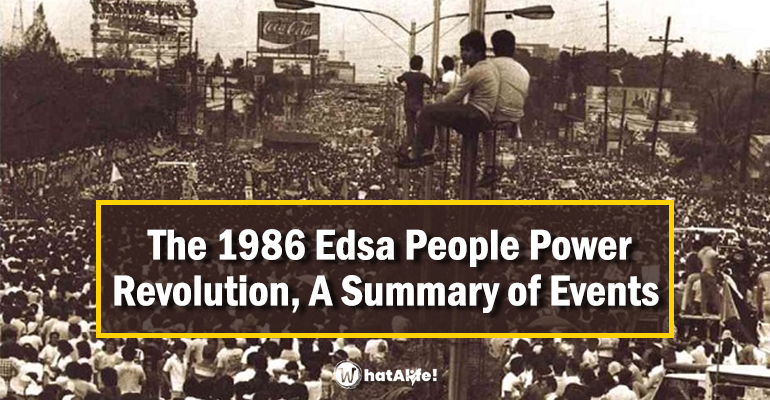It has been 36 years since the peaceful revolution of millions of Filipinos along the Epifanio de los Santos Avenue (EDSA) and other cities in the country created history. This event attracted not only the attention of the locals but also the international community. In this blog, we will look back at the historical past, explaining why February 25 is celebrated every year in our democratic country.
What is the EDSA Revolution?
While we learn about history in school, it is important to refresh our memory about the important events in our country. This section will answer common questions related to the meaning of this momentous occasion.
What is EDSA?
The 1986 EDSA People Power Revolution was a peaceful protest of millions of Filipinos united against the dictatorship of former president Ferdinand Marcos Sr. It was led by Cory Aquino, who was then elected as the 11th president of the Philippines after the defeat of Marcos.
Commonly known as “EDSA,” the 1986 People Power Revolution was the people’s response to the decades-long rule of Marcos Sr., including the 10 years of martial law that had brought a dark time to the country, especially the enemies of the Marcos regime.
Why Did the EDSA Revolution Happen?
In 1965, Marcos Sr. was elected president of the Philippines. However, in September 1972, he declared martial law to hold on to his post as the most powerful person in the country. There were already many protesters to his regime, including his greatest critic – opposition leader Senator Benigno “Ninoy” Aquino Jr.
Senator Ninoy was exiled to the United States. But, when he returned to his home country, he was assassinated on August 21, 1983, which resulted in a stronger spark of revolution led by his wife. There were also rumors at that time about the failing health of the dictator who was suffering from lupus and underwent regular dialysis. This rumor created turmoil between his allies, who began speculating about his successor.
On February 7, 1986, a snap election took place due to international pressure on the president. Then, on February 20, Marcos declared himself the winner despite allegations of fraud and violence. However, this announcement was met with ire as the National Movement of Free Elections (NAMFREL) at that time disputed the results of the Commission on Elections (COMELEC).
Two days later (February 22), after the declaration of Marcos as the winner, Cory Aquino led a protest rally estimated to have gathered millions of Filipinos in attendance along EDSA. The EDSA People Power Revolution protest lasted for 4 days until February 25, 1986.
What Happened In The EDSA Revolution?
There were many key highlights during the EDSA People Power in 1986. Other than the events happening outside the Malacanang Palace, inside was turmoil.
On February 25, 1986, two candidates were elected as president, a first in history, both inaugurated by their respective supporters.
While Marcos was being sworn into office by then Chief Justice Ramon C. Aquino, a few minutes before noon of the same day, the televised coverage of the event was abruptly interrupted. This was due to military rebels, supporters of the EDSA rally, disabling the transmitter of the Marcos-controlled channels 2, 9, and 13. However, the oath-taking proceeded 20 minutes later.
On the evening of February 25, Marcos, his family, and close allies fled to Hawaii. This was after close ally President Ronald Reagan sent word through Senator Paul Laxalt that they will no longer back Marcos. The U.S facilitated his escape to the American state of Hawaii, where he stayed until his death on September 28, 1989.
By then, the 11th President of the Philippines, Cory Aquino, took office in Malacanang Palace.
What Prevented Bloodshed In The EDSA Revolution In 1986?
The EDSA Revolution in 1986 did not go unchallenged by the Marcos regime. Through his military powers, Marcos ordered soldiers to put a stop to the uprising of millions in Metro Manila Avenue.
Cardinal Jaime Sin, the then Archbishop of Manila, called upon Filipinos to support the relatively peaceful protest led by opposition leader Cory. When Marcos ordered the military to repress the mass action, a faction of military officers refused and chose to defect instead.
This group was, known as the Reformed Armed Forces Movement (RAM), had grown frustrated with the corruption in the military. After their defection, Cardinal Sin once again called upon the people to shield them.
Moreover, the corruption of Marcos during the snap elections led some of his former ministers, the army, and the Catholic church to call for his removal from office. This united call further strengthened the courage of Filipinos to gather in peaceful protests around the country.
One of the most notable events during the 4-day protest was on day 2 when the president sent tanks to clear the street. In the act of defiance, the troops refused to fire on the huge mass of unarmed people. To this day, the image of nuns kneeling in front of tanks praying hard with their rosaries remains one of the most iconic images of the 1986 revolution.
Is EDSA Revolution A Regular Holiday?
Yes, the EDSA Revolution anniversary is a holiday in the Philippines. However, this all depends on the proclamation of the sitting president. For instance, former President Gloria Macapagal-Arroyo signed Proclamation No. 1841 in 2009, declaring the EDSA People Power Anniversary as a “Special Holiday (for all schools).”
In 2015, former President Benigno “Noynoy” Aquino III (son of Cory Aquino and Ninoy Aquino) signed another proclamation declaring the anniversary as a “Special Holiday (for all schools)” too. But, since 2016, the anniversary continues to be declared as a “Special Non-Working Holiday.”
This year, President Rodrigo Roa Duterte signed Proclamation No. 1236, declaring February 25, 2022, as a Special (Non-Working) Day to “commemorate the 36th anniversary of People Power Revolution, which restored democracy and ushered political, social, and economic reforms in the country. – WhatALife!
Source: (officialgazette.gov.ph)



Leave a Reply